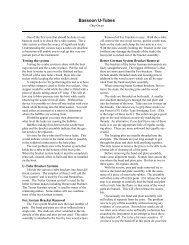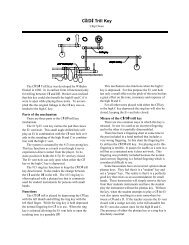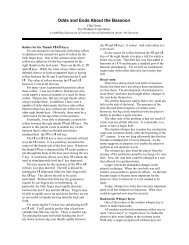English Horn playing guide pdf - Fox Products
English Horn playing guide pdf - Fox Products
English Horn playing guide pdf - Fox Products
You also want an ePaper? Increase the reach of your titles
YUMPU automatically turns print PDFs into web optimized ePapers that Google loves.
10<br />
ASSEMBLY AND CARE OF THE ENGLISH HORN (CONTINUED)<br />
THE BOCAL<br />
The bocal is extremely influential in the sound and tuning<br />
of the <strong>English</strong> horn. Bocals are available in varying lengths,<br />
with #1 being the shortest, and #3 being the lowest in<br />
pitch. Individual bocals can vary in tone color, response,<br />
and dynamic range, so it is important that the instrument<br />
you choose has a well made bocal to complement it. Treat<br />
the bocal with care, so as not to bend or dent it, and clean<br />
it out periodically with warm water, a mild detergent and a<br />
pipe cleaner.<br />
ADJUSTMENTS<br />
Unless you have had some experience with adjusting<br />
woodwinds, it is best to let an experienced repairperson<br />
handle adjustments. Often, a small problem can become a<br />
big one with a screwdriver in untrained hands.<br />
REEDS<br />
The <strong>English</strong> horn reed differs from the oboe reed in two<br />
ways. First, the reed is not inserted into the body of the<br />
instrument, but is instead fit over the end of the bocal.<br />
Second, the reed usually has a thin brass wire wrapped<br />
twice around the reed about 6mm above the winding.<br />
The wire is not essential, but it serves to stabilize the size<br />
of the opening. The length of the reed and staple together<br />
is from 53 to 56mm. The material in the oboe manual pertaining<br />
to the adjustment of reeds is equally applicable to<br />
<strong>English</strong> horn reeds. Only the proportions are somewhat<br />
larger. For anyone who wishes to go into reed making in<br />
greater detail, a fine reference is David Weber’s book<br />
“The Reed Maker’s Manual.” An accompanying videocassette<br />
is available. Another fine text is “The Oboe Reed<br />
Book” by Jay Light.<br />
REED CASES<br />
It is important to have a reed case that supports the reed<br />
in such a way that nothing can damage the delicate tip. It<br />
should also allow for air circulation around the reed to<br />
keep it dry when not in use. There are commercial reed<br />
cases available or cases can be made by the student. Do<br />
not use the plastic tubes in which some commercial reeds<br />
are packaged. They do not permit thorough drying of the<br />
reed between uses.








